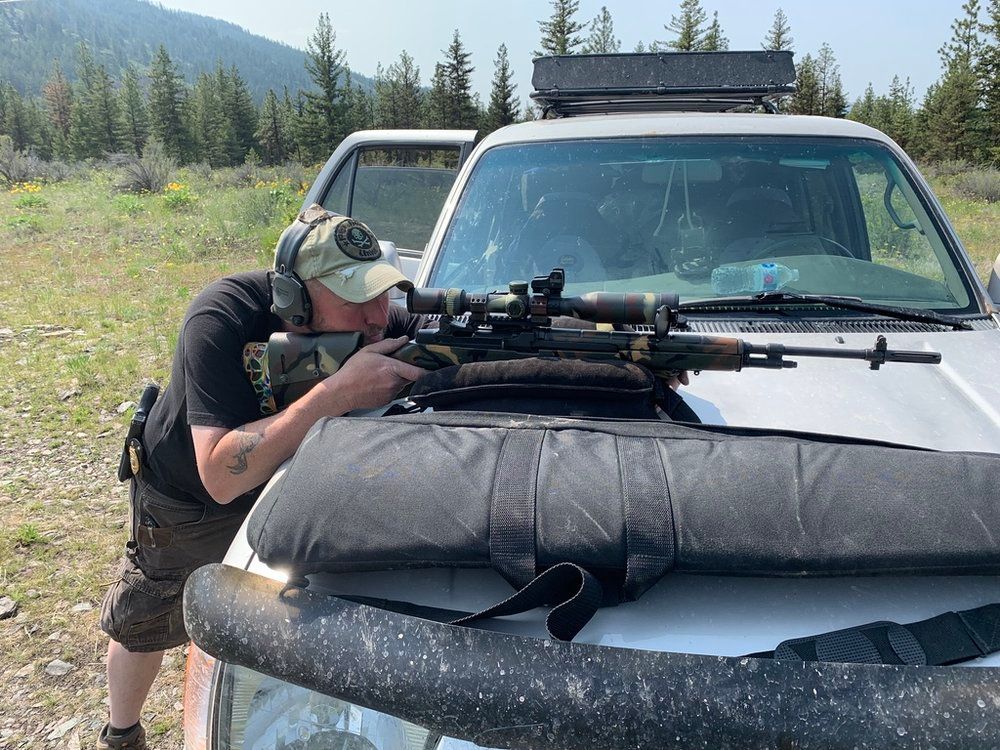Over Memorial Day weekend, I took Eric Pfleger’s Longrifle and Rural Scout/Sniper classes. The Longrifle class ran Saturday/Sunday and focused on long-range shooting, while the Rural Scout/Sniper course on Monday and Tuesday covered stalking and the intel gathering role of a sniper.
Eric is a sniper on a regional SWAT team in a very rural area, so he’s one of the small percentage of police snipers who’s actually going to get a lot of mileage out of a ghillie suit. This sort of thing is right in his wheelhouse. I’ve taken the Longrifle course before when Eric taught it at Thunder Vally Precision in Ohio. The Rural Scout/Sniper has some overlap with the Pathfinder, Reece, & Man Tracking course that Eric did a couple of years ago, so the curriculum wasn’t totally new to me, but I’m still generally a novice at this sort of thing so more instruction from someone as knowledgeable as Eric was quite welcome.
After the class, I stuck around for the rest of the week to enjoy Montana a bit.
Gear
Long range rifle classes are generally very gear intensive; this one even more so because we’d spend one night camping in the field. That posed a problem for me since I’d be flying in from Kansas.
Despite the fact that I was flying in, I decided to bring two rifles to this class. I wanted to bring out my Ruger Precision Rifle for the long-range shooting portion of the course, but it’s kind of heavy and unwieldy to carry around in the field. For the field work, I brought out my new .308 AR.
The RPR hasn’t really changed since the last class I brought it to. As before it’s got a 3-18x Vortex Razor HD II on it and I’ve replaced the factory stock with a Magpul PRS. One change I did make was to switch from the Atlas bipod to one of the new Magpul bipods. I did this so I could have one bipod on each rifle, rather than swapping the Atlas back and forth.
The .308 AR is a build I put together, using an Aero Precision upper, lower, and handguard. I’m running a Nightforce ATACR 1-8x on it, in a tall American Defense mount. This is more of a general purpose rifle rather than being optimized solely for long range or precision shooting. I figured it would work well for the Scout/Sniper portion of the class.
When I was testing the gun, I was getting some failures to eject with the spent case hanging out like a stovepipe, jammed up underneath a fresh round that was partway into the chamber. I took some slow motion video to help diagnose the problem. I came to the conclusion that the rifle was probably overgassed, leading to the bolt carrier group coming back fast enough for the extractor to lose its grip on the rim of the case before the case had a chance to reach the ejection port. After a heavier buffer failed to solve the problem, I ended up installing an adjustable gas block. I did not get the chance to run as many rounds through the rifle as I would like before bringing it to class, but during the testing, I was able to do I didn’t have any more malfunctions after getting the gas block adjusted, and ejection was much more vigorous and consistent.
Both rifles have QD mounts for my AAC 762-SDN-6 suppressor. Only one can, so I had to swap it back and forth between them.
This is grizzly bear country. While my .308 would be my go-to for bear defense, I might not always have that in hand. I brought a 10mm Glock. One issue when running a big pack is always how to carry a pistol and accommodate the pack’s belt. My favored solution for this is a dropped and offset holster. This puts the pistol low enough and far enough out from the body to clear the pack belt without tying it to your thigh the way a drop leg holster does. Whenever you’re crawling around in the bush, it pays to have some sort of retention. I ran a dropped and offset Safariland ALS holster.
In a class like this, optics are as important as rifles. In addition to the rifle scopes, I also brought my Leupold Mark 4 12-40x spotting scope with a Horus reticle in it. After my experience hunting in Montana the past two years I decided to upgrade from separate binoculars and laser rangefinder to a set of binos with a built-in rangefinder. I picked up a pair of the Vortex Fury 10x42s for this class (I also brought my old Leica 1600 rangefinder and Vortex compact 8x binos).
On my past hunting trips and classes, I’ve run the binos on a Leupold binocular harness, but I’ve found pulling up against the tension of the harness annoying, and it can make it hard to keep the binos steady for long periods. This time I brought a Badlands Bino Mag case that provides the binoculars a bit more protection while keeping them readily accessible (ok, it also looked really cool in Wind River). The case has dummy cords in case you drop the binoculars, but they aren’t under tension the way a harness is. I used a set of Peak Design Anchor Links, so I could detach the binos from the dummy cords when I wanted to use them separately.
This is definitely a course where camo is appropriate. I favor Multicam, and the terrain in Montana is quite suited for it. I brought some Crye combat pants (one pair of G3s and one of the new G4s) and Tru-Spec Multicam shirts. Throw in a pair of Multicam Under Armour boots and a Multicam boonie, and I was pretty much cammoed up head to toe.
Being Montana in the springtime, the weather was potentially pretty variable. I wanted to be prepared for everything from hot days to sub-freezing temps, sun to rain (probably not snow, but even that was possible). So, long underwear, fleece, insulated gloves, neck gaiter, and watch cap for the cold. For windy and wet, a full set of Multicam Gortex including a rain jacket, rain pants, and gaiters.
Since we’d be camping out in the field for a night during the Rural Scout Sniper portion, this class also required camping gear. I mostly brought my usual backpacking kit: a small tent, sleeping bag, Thermarest mattress, etc. I did upgrade my old backpacking stove to a new Jetboil model for cooking dinner and breakfast.
I brought a pair of 2-liter water bladders as my main water source, along with a Nalgene bottle (sometimes a bottle is more practical than a bladder, particularly around camp). To keep these full of fresh water, I got a new Sawyer Squeeze water filter and some Katydn Micropur purification tablets.
Finally, food. For the overnight, I brought my usual sort of backpacking rations: noodles and canned ham for dinner, instant oatmeal and hot chocolate for breakfast. Knowing Eric, I figured that during the days it would be mostly eating on the go rather than lengthy meal breaks, so I brought a lot of snack type stuff: Cliff bars, GORP, pretzels, jerky, beef sticks, etc.
Of course, I also needed some way to carry all this stuff. Eric told us to be able to carry all of our kit to our camping location on foot, then carry our food, shooting, survival, and inclement weather gear with us as we moved around to different locations during the day. So, a big ruck to carry everything and a smaller bag to carry the daytime kit.
This sounded like a job for my Eberlestock Skycrane. The Skycrane is less of a “pack” and more of a flexible system for securing heavy loads to your back. The base pack includes a frame, shoulder straps, and waist belt. Its only enclosed cargo space is two long side pockets. You can load this frame up with Eberlestock’s Little Brother pack and their Spike duffel bags in various combinations. I squeezed all of my daytime in the Little Brother and loaded up the Spike and the side pockets with my camping gear. When I did my test pack (which didn’t quite include all of my gear or ammo), the day pack came in at about 30 pounds, and the full setup was over 55 lbs. Throw in the remaining kit, and it’ll probably tip the scales at over 60 pounds (not counting rifle, scope, pistol, or binoculars).
This was all way too much for checked luggage with the airline. Fortunately, Eric was willing to receive packages for students ahead of time. For some stuff like ammo and stove fuel that can be a pain to ship, I bought it online and had it shipped directly to Eric. I packed most of my gear in one big box and shipped it out the week before class. On the airplane, I had one big rifle case with the rifles and pistol in it and a large rolling suitcase with my clothes and other gear. Rather than trusting my expensive optics to UPS or the TSA and airline baggage handlers, I got a carry-on sized Pelican case and brought them with me on the plane.
Friday
I arrived in Missoula in late afternoon. Eric was nice enough to pick me up at the airport. He was putting me up for the class in his fifth-wheel trailer, which was parked on a piece of property where he was also hosting some students from the class who were tent camping. After dropping my gear off at the fifth wheel, a couple of other students and I went out for dinner with Eric and his family.
Saturday
I rolled out of bed early on Saturday and got to work sorting out my gear. It was pretty well mixed up, with gear spread between my checked suitcase, rifle case, carry on, and the stuff I had shipped out ahead of time. Thankfully I could ignore a lot of it until Monday, (mostly the camping stuff) but I still needed to assemble all the shooting gear, some food, and other random stuff I’d need today and tomorrow.
We convoyed from camp out to the rendezvous point (a gas station on the highway where we’d be shooting). Eric briefed everybody on where we were headed today, and we made the short drive out to where we’d be shooting.
We started out with introductions. There were some folks who’d made long trips to attend this class (even longer than mine). He had us team up into two-man teams (shooter/spotter). My buddy for this class was a guy who goes by cdiesel on the Paragon Pride forum. He was shooting a SCAR 17 with a 3.5 power ACOG, so a very different setup (particularly compared to my RPR with the big 3-18 optic on it).
Most of the students in the class were running bolt guns, though there was a substantial minority with semi-autos (mostly ARs of various flavors, plus cdiesel‘ s SCAR). The most common caliber was .308, but there were a number of 6.5s in evidence, as well as one .224 Valkyrie.
Eric gave the medical brief. Since we’d be training in remote locations this was fairly in-depth, with designated medical personnel, incident commanders, note takers, runners, communicators (including instructions on how to get comms with county dispatch), and even designating responsibility for who would be responsible for signaling a helicopter if we had to call in a medivac.
To avoid having to put any of these preparations into practice, Eric did the safety brief. In addition to the standard gun stuff, Eric talked about snakes, badger holes (don’t want to turn an ankle), hydration, and other environment-specific threats. On the gun side, pistols could stay live in the holsters, while sniper rifles needed to be unloaded when not on the line and shooting. Eric demoed his preferred unloading procedure. The element I particularly like about how he does it (which I have incorporated into my own unloading process) is that he does visual and tactile checks of the weapon’s chamber and magwell, then looks away from the gun before checking a second time. This diverting attention away from the gun is key to breaking up the two checks and making it less likely that you’ll miss something.
Eric had everyone grab a pistol, binoculars, and a notebook and writing implement. This is the bare minimum of what it takes to function as a spotter or observer, and Eric wanted everyone to have it on them at all times during the class.
He talked a bit about the sniper mission, and the way it combines observation and precisely delivered fire.
This segued into a lecture on Tier 1 gear; the gear that you carry directly on your person. Eric went through what he carries and why. For a sniper, this usually includes a rifle and ammo, but also survival kit, nav equipment, and sustainment gear.
Eric is known for his epic gear lectures, but in this class, he was making an effort to break it up over the four days, rather than going on for hours at the start of day one. After covering the Tier 1 stuff, we moved on to a Kim’s game. Eric had a dozen items laid out on a piece of cardboard and gave us three minutes to memorize everything we could about them.
Before going out and shooting Eric went through the basics of shooter-spotter communication. It’s important to tell your partner when you’re on target and ready to shoot so he can observe the effect of your shots. Since we’d be shooting in an area with some high grass, Eric also covered some methods for getting more elevation, including using your spotter’s rifle, or your spotter himself, as support.
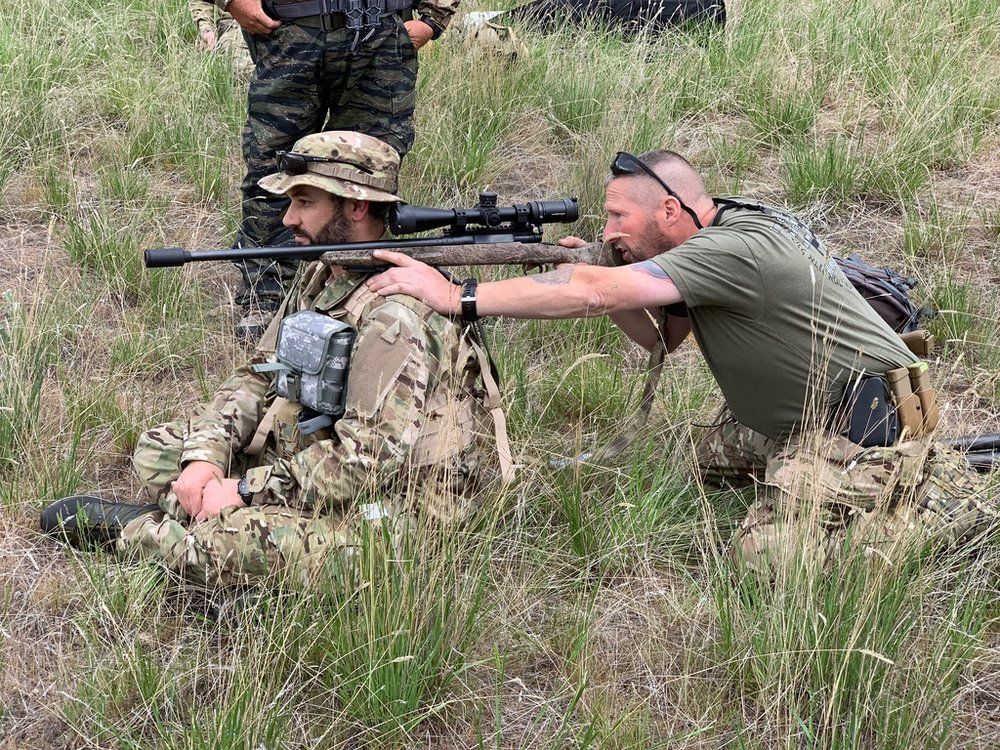

We shot at 100 yards to confirm zeroes and adjust as necessary. It took a couple of iterations, but eventually, everyone was happy with their zeroes.
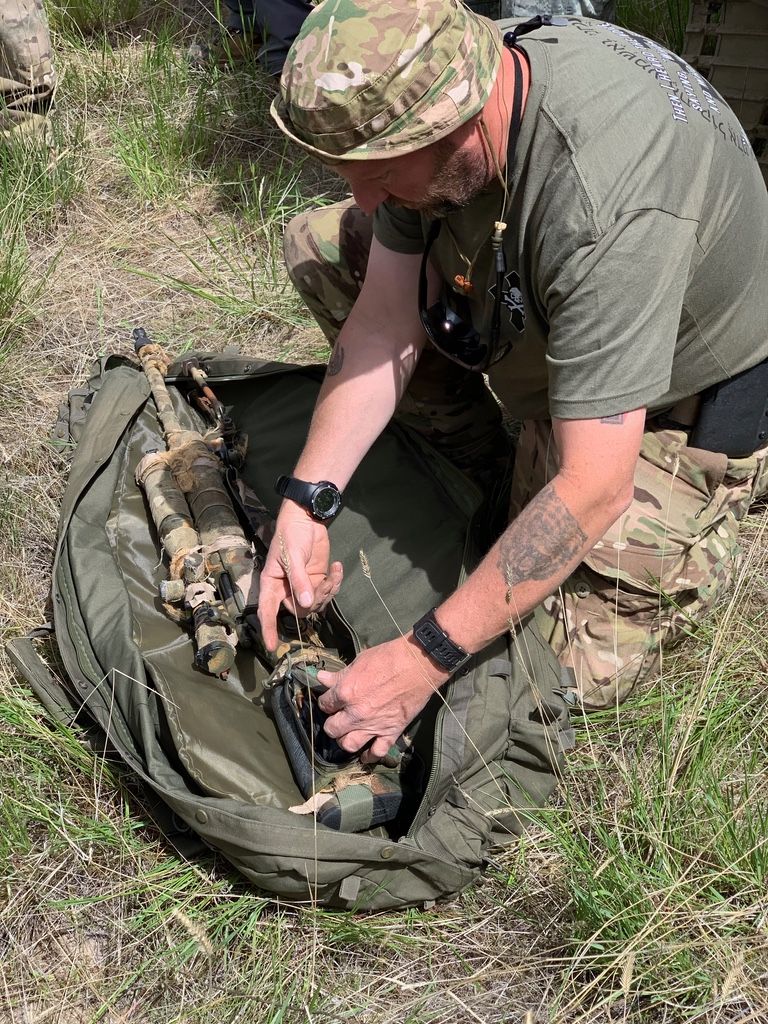
Eric did another brief gear lecture, talking about the gear he keeps in the stock pouch on his main .308 sniper rifle, including a few rounds of ammo, laser rangefinder, dope cards, a calculator, and a tape measure. He also broke out the whiteboard and talked a bit about ballistics and zeroing, showing how the trajectory of the bullet relates to your line of sight through the optic.
Before getting back to shooting, Eric also went through the contents of his soft case/drag bag. He’s got bigger support gear in here, like a spotting scope and suppressor, more ammo, more dope cards, etc. Between this and the stuff on the gun, he can grab one case and combined with the Tier 1 gear on his person he has everything he needs to deploy as a sniper.
At that point, we switched from bullseyes to photo targets of human heads. Eric talked everyone through the aiming points on the human head, aiming for that perfect “lights out” shot. Eric’s head pictures are not all straight on presentations with the target directly facing the sniper, so you have to visualize where those critical parts of the brain would be based on the head’s orientation (Eric noted that a good way to do this is to think about where you want the round to exit). We ran this drill a couple of times, pasting up new pictures so people had experience shooting at several different heads in different orientations.
We got our first dose of rain, but it was fairly light (barely worth breaking out the Gortex).
On one iteration of the headshot drill, Eric had everyone deliver coordinated fire, doing a count and firing together on three. On the following iteration, he had us do the same thing within our two-man teams. Doing it within the team is a bit harder because someone has to both shoot and do the count. That can make breath control and getting a good trigger press challenging. I ran the count and cdiesel and I were able to get good simultaneous shots.
We moved over to a neighboring draw where Eric had set out various objects and had us search for them using our binos and spotting scopes. Some of them were pretty obvious, others more subtle. Perhaps most notably, he had a ghillie suit set up as an enemy sniper, with a foam head and spotting scope. The sunglasses and spotting scope are surprisingly visible at distance. They were what really made it possible to distinguish the ghillie suit from a big bunch of vegetation. Optic lenses are definitely something you need to camouflage.
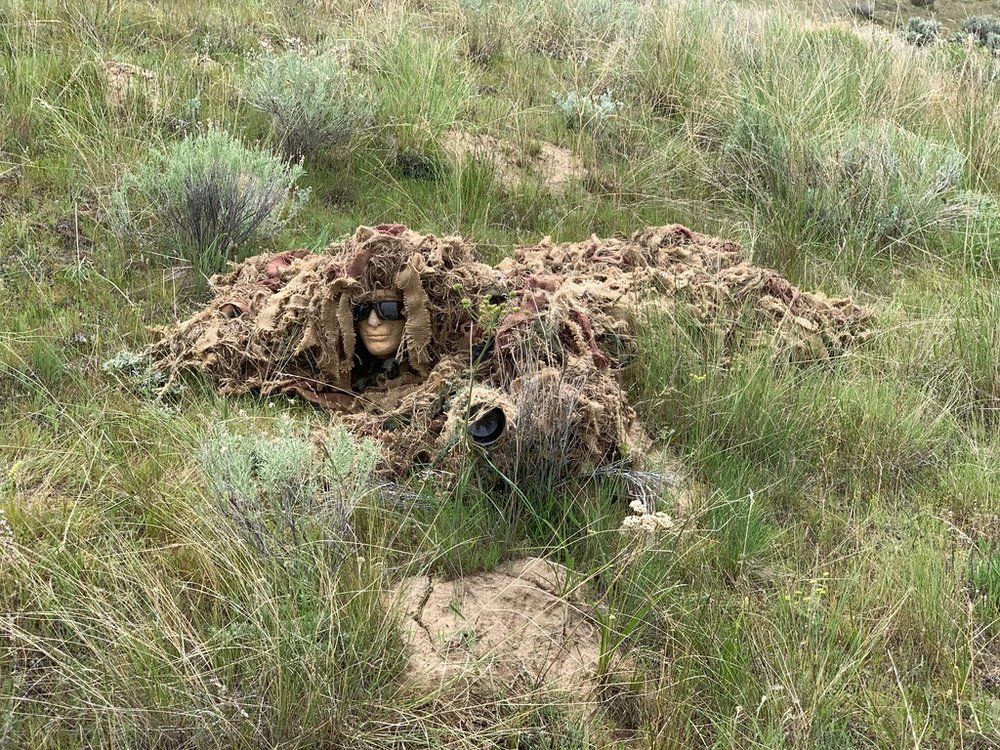

We moved back and debriefed the Kim’s game from this morning to see how much we had been able to remember. Eric talked about doing Kim’s games with vehicles and people, picking out and memorizing characteristics that make them identifiable.
Since he’d used the ghillie suit during the glassing exercise, Eric talked a bit about ghillie suit construction. He had examples of both a full ghillie suit and a ghillie cape that he keeps with his main sniper bag. The cape can be pretty effective at breaking up the human outline without being as hot or heavy as a full ghillie suit.
Switching to some shooting, we moved back to 200 yards. At this distance, the grass was too high to shoot from prone. We had to use various means to get higher to engage the targets. I ended up standing my pack up on end and resting the rifle on that. cdiesel and I were able to get good headshots that way.
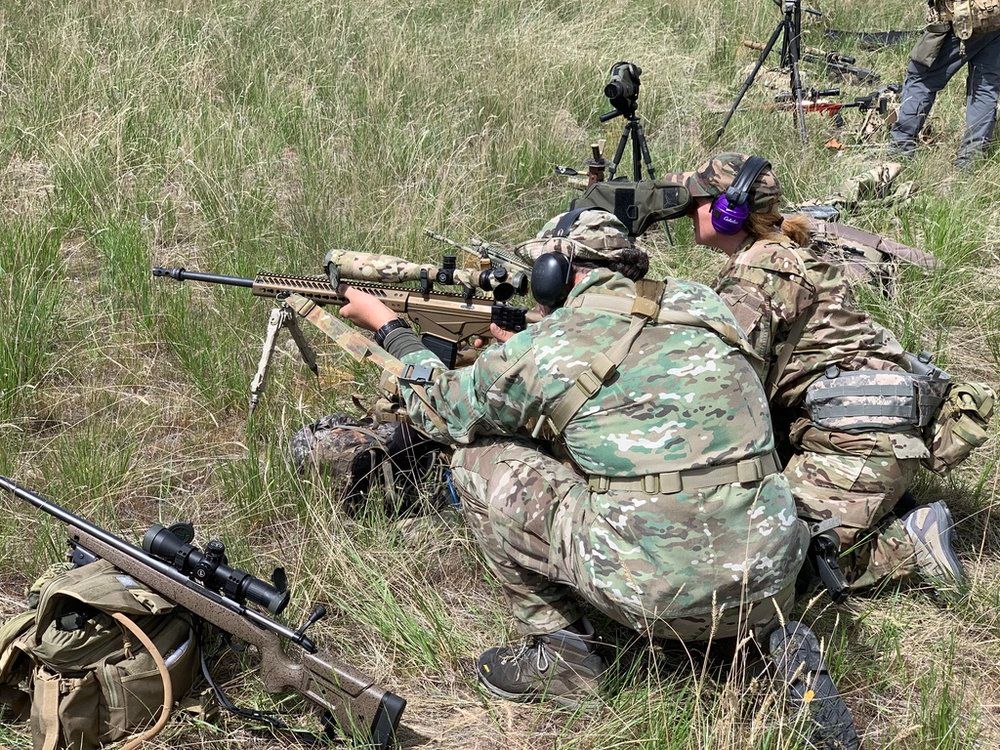
Eric noted that snipers have two movement speeds in the field: crawl and run. He ran us back from the targets a couple of times to get our heart rates up before firing.
Moving back to 300 yards, again we weren’t able to shoot from prone. Since we were getting far enough that my spotting scope wasn’t doing much good seeing holes in the paper, I pulled it off of the tripod and put my shooting saddle on there. I found I could rest the front of the rifle on the saddle and sit with my pack against my chest to provide rear support. This was a very stable position.
We started out with some headshots, though this is pushing the distance that you can deliver a perfect lights-out shot. We moved on to painting some circles on the targets and using those as aiming points.
Finally, we pulled back to 400 yards. Here we had a bit of elevation and some shorter vegetation, so we were able to shoot from prone again. After everyone was satisfied with their hits at 400, we packed up our gear and loaded the targets on the truck.
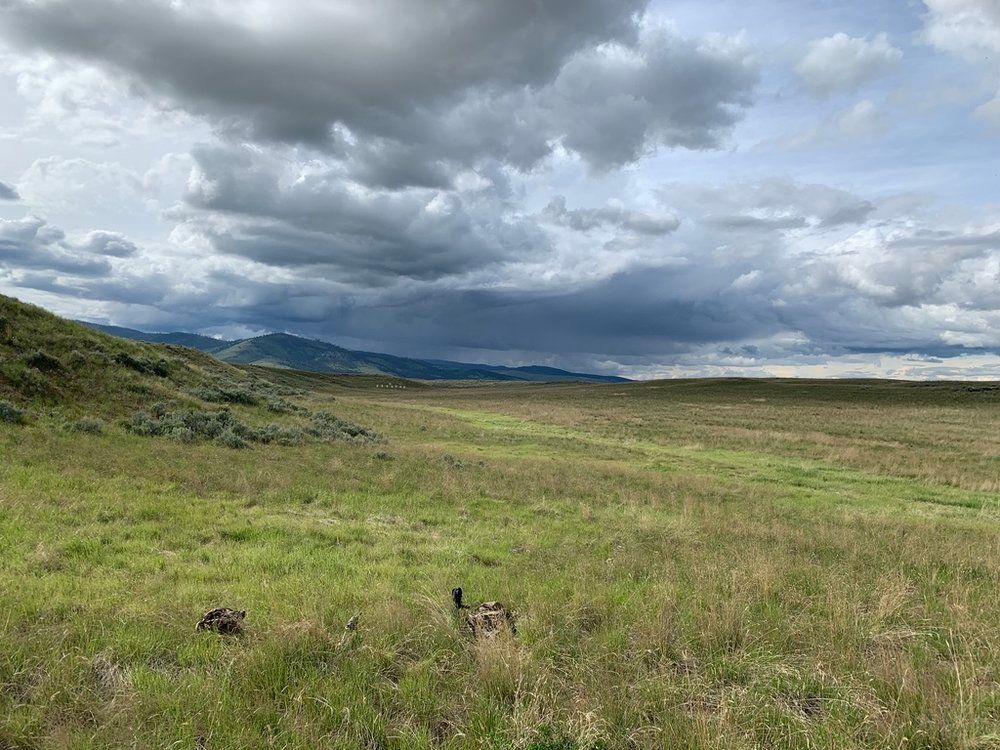
Our last exercise of the day was doing some ranging with mil-reticle optics. Eric did a brief lecture on how to calculate the distance to a target based on its size in mils. Standard sized objects like street signs and license plates are good for this sort of thing. He gave us a card with dimensions of these sorts of common objects. This is also why Eric emphasizes a sniper carrying a tape measure, so he can measure stuff in the field and build his database of standard sized objects. What’s useful to know will vary depending on your AO. If you’re someplace overseas where there are lots of Toyota pickups being used as technicals, then knowing the height of a Toyota door or the size of its tire will be useful. Same thing for standard door heights, the transformers on power poles, and other objects or features you find in the environment.
Eric had scattered some road signs and a license plate out in the field. We ranged them with our mil-reticle optics and worked the math, then confirmed with laser rangefinders. I did pretty well with the mil reticle in my spotting scope. The folks running mil reticles in binoculars had some challenges holding things steady enough. I like having a mil reticle in binos for other reasons, but they’re not great for ranging.
We headed back to Eric’s place, where he cooked up a bunch of antelope and lots of mashed potatoes. Several folks had brought growlers of beer and a small keg. I broke out the nice bottle of rye I brought while another student had some good tequila. We all hung out and talked for a couple of hours.
Sunday
On Sunday morning, we rendezvoused at a different gas station. From there we drove out to an actual shooting range for a couple of exercises. First up was shooting moving targets.
Eric set this up on a 100-yard rifle range, with half the class beyond the berm carrying targets back and forth on tall sticks while the other half shot. This did mean that we were shooting over the berm, but we had a whole mountainside as a bullet trap. Eric explained how to lead targets based on movement speed and distance.
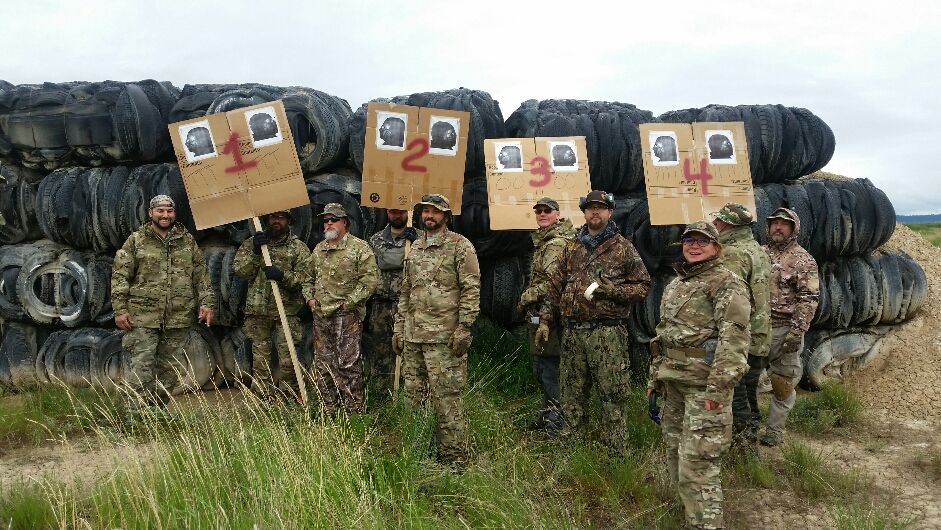
There are two ways to shoot while leading a moving target: tracking and trapping. With tracking, you swing your rifle with the target as it moves and creeping slightly ahead to provide your lead. Trapping involves keeping your rifle stationary using the horizontal crosshair to figure when the target gets to the point where you’ve got the appropriate lead, and allowing the target to walk into your bullet.
Each relay got a couple of dry runs to get the right magnification and practice leading the targets, followed by a live run. We went down and checked the targets to see how we did. I’d gotten my lead right, but I was quite a bit high. This was surprising because while my trigger press was far from perfect if anything, I shanked it low. Then I realized that I’d left my 400-yard adjustment dialed in from yesterday. Always return your turrets to zero!
We got set up again and did two live runs, one moving in each direction. Having got my rifle dialed properly, I did a bit better this time. On the last run, I actually tried engaging multiple times, trapping for the first shot, then running the bolt and switching to tracking for a second shot.
Next, we moved over to the pistol range to practice transitioning from rifle to handgun. Eric had us start off just drawing and shooting from the holster, to make sure everyone could safely get the gun out and deliver handgun fire.
If a sniper armed with a bolt gun encounters a sudden close range threat the best course of action is probably to fire one shot with the rifle, then switch to handgun. With a high magnification optic delivering that first shot at close range may be a challenge. Eric talked a bit about point shooting, specifically using the top turret of your optic with “metal on meat” point shooting.
We drilled taking one shot with the rifle, then slinging the long gun and transitioning to pistol. Rather than metal on meat, I just rolled the rifle over a bit and sighted down the handguard, which works well with the nice straight lines on the RPR’s forend.
Finally, Eric talked about responding to threats when you’re proned out behind the rifle. He demonstrated responding to threats to either side, but for the drill, we would be responding to a threat to the rear. We started out on our dry rifles, facing uprange. On command, everyone rolled over off the gun, sat up, and drew their handgun and engaged the target.
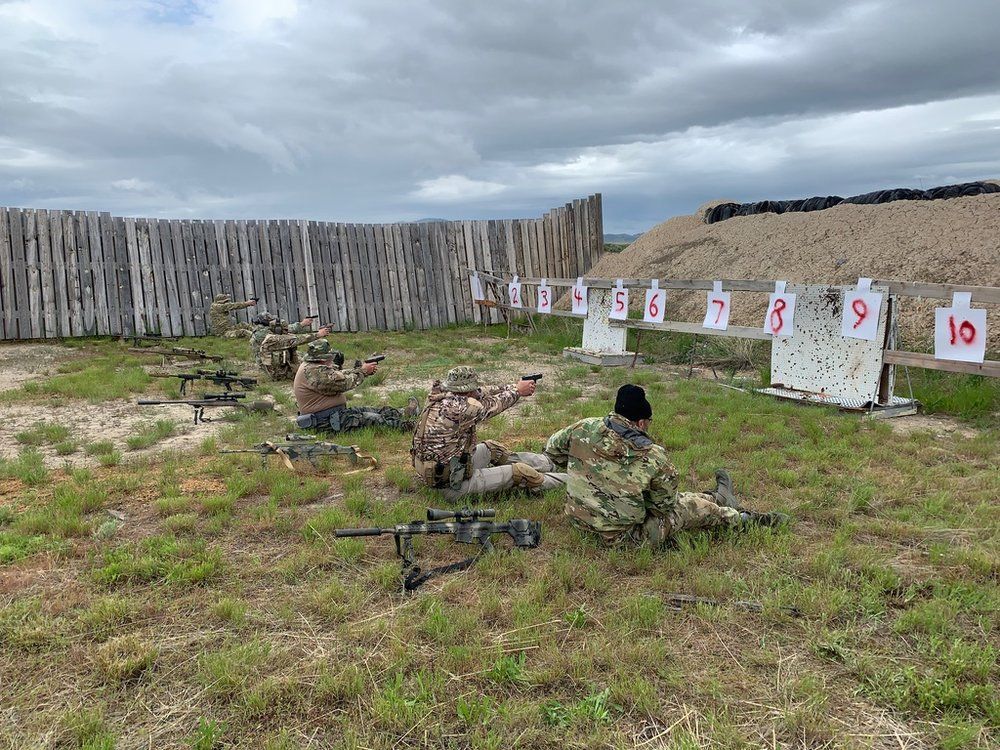
During these drills, I got had several malfunctions with my 10mm Glock. They appeared to be light primer strikes. Since I’d be relying on this gun for bear defense over the following two days (not to mention as my self-defense gun for the rest of the week), this concerned me quite a bit.
As Eric had said the previous day, snipers in the field have two speeds: crawl and run. He comes to this range and qualifies with his duty sniper rifle every week. As part of that he runs up to the gate and back (about a quarter of a mile) with his rifle then takes a 100-yard headshot. Eric had us shoot this drill. He emphasized that we should pace ourselves on the run, including walking some or all of the distance if necessary (he didn’t want to give anyone a heart attack). However, if you’re not getting yourself winded by the end, you’re not really getting full value out of the drill.
A couple of years ago when I was carrying a lot more weight and not doing as much exercise, this kind of drill really would have sucked for me. However, I think I did pretty well both on the run and in delivering the headshot at the end. I was definitely feeling the weight of that big, heavy rifle though.
We loaded up the vehicles and made a drive out to some land Eric had permission for us to shoot on about 10 miles east of town. Here we could push to longer distances than the spot where we’d been shooting the day before.
After setting up some steel, Eric did another chunk of gear lecture, talking through the contents of his sniper ruck. He covered a couple of alternatives, like a battle belt, sniper vest, or shoulder bag, with examples of each. However, he spent most of the time going through his primary sniper ruck: a medium-sized backpack. As you’d expect from Eric, it’s very well thought out, both in terms of what he’s carrying and how he’s got it laid out with shooting gear on the exterior and sustainment gear inside.
Eric had us move to shooting positions up on a bluff. Rather than just walking up there he had us move somewhat tactically up from the road (though this was not intended as a stalking exercise). Eric talked a bit about vehicle insertions, including one that he did when antelope hunting (which actually has quite a bit in common with sniping). Basically, the vehicle slows down, and the sniper chucks out his pack and hops down while the vehicle is still in motion. We simulated this rather than actually doing it, then moved up to our firing position. While this was not a stalk, Eric did have us crawl from the point where we got to the crest of the bluff into our shooting position.
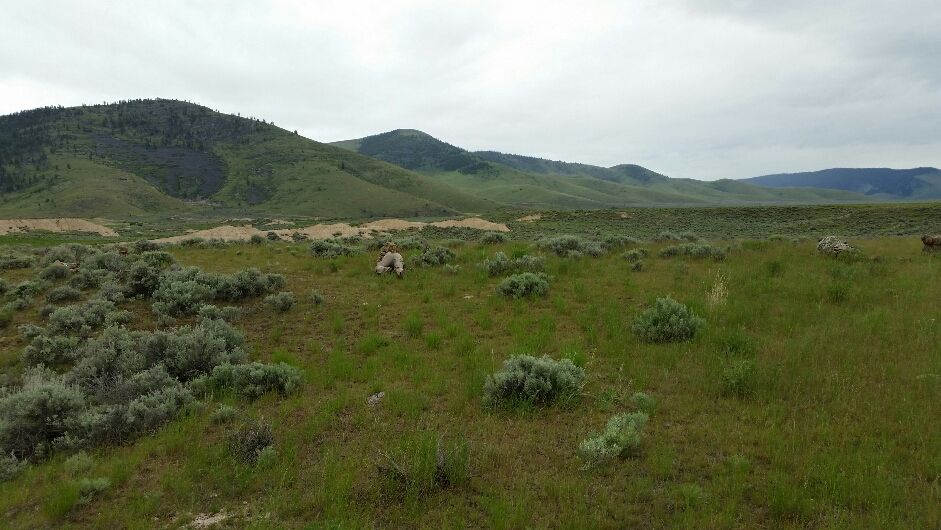
One problem many students encountered with this was the “buffalo hump” issue. While your body may be low, that ruck on your back is sticking up and wiggling around as you crawl. Unless you’re moving through very high cover, you really need to get that ruck off and drag it.
Another gear specific issue that cropped up was with the Badlands binocular case that cdiesel was running. He was using one that included a smaller, second compartment on the bottom for a laser rangefinder. When low crawling, this tended to rub against the ground and pop open, dumping out his LRF. He didn’t have the rangefinder dummy corded, so he had to go back and look for it. Clearly, this bino case wasn’t built with a low-crawling sniper in mind.
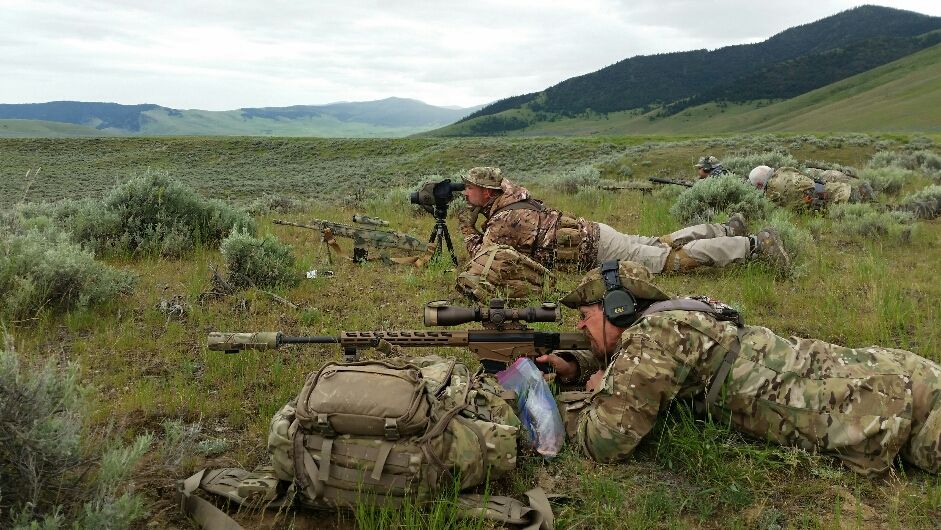
Once in position, we did some shooting from about 500 yards. At first, I was off by quite a bit, until I realized that I’d been looking at the dope card for my .308 rather than my 6.5 (there’s about a mil difference between them at this distance). After I fixed that screwup and got a feel for the wind, I was able to bang some pretty small targets (verging on MOA sized).

We did our initial shooting from prone, but after a while, Eric had everyone rally up and demonstrated some techniques for shooting from sloped terrain, shooting uphill and downhill, as well as cross-slope. He had everyone push forward over the lip of the bluff and do some shooting from the slope (which was fairly steep, about 45 degrees). This was kind of tough with my big, front-heavy rifle. The best way I found was to raise my support side knee and brace the back of the bipod against it, then kind of come in from the side and peek through the scope. cdiesel actually had it quite a bit easier with better-balanced SCAR.
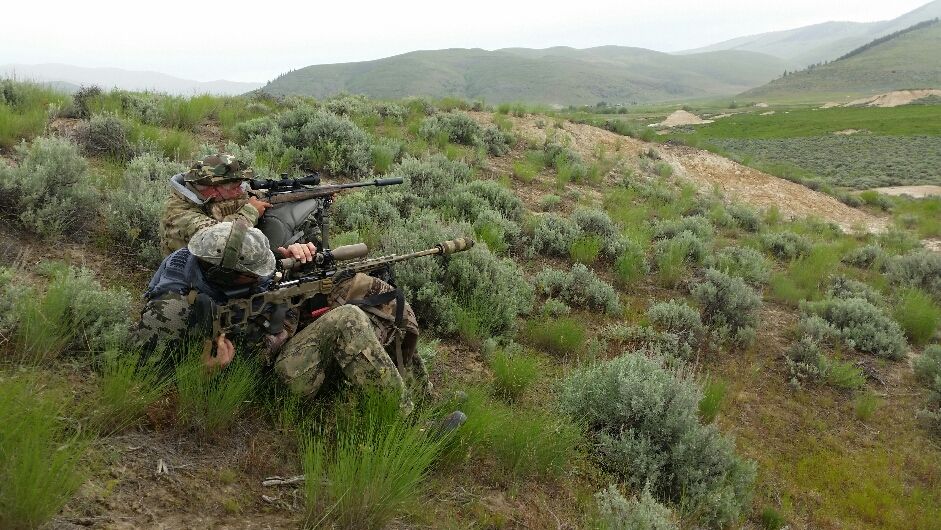
Since cdiesel and I were on the extreme left where the bluff curved around, Eric encouraged us to take advantage of this and try some cross-slope shooting as well. This was considerably easier. I could just use my ruck for support. The only hard part was figuring out what to do with my strong side elbow (splaying it out was less comfortable, but seemed to be more stable than tucking it underneath my body).
As we walked back to the vehicles, Eric went through the 10 deadly “S”s that will betray your position to someone trying to observe you: shape, shadow, shine, silhouette, spacing, speed, scent, sound, signal, and spoor.
We relocated the steel, then drove back out to a position where we could shoot out to longer distances, starting at about 800 yards. I found that I was missing my rear bag. I’d used it when we were shooting off the bluff, so I must have left it up there (spoor). I let Eric know, and he said he’d have a look next time he was out here shooting.
Shooting without the rear bag was a bit harder, but I got good hits at 800. This sort of distance was really pushing the SCAR and ACOG, though cdiesel got better results when he switched from the M80 ball that he’d been shooting to some match ammo.
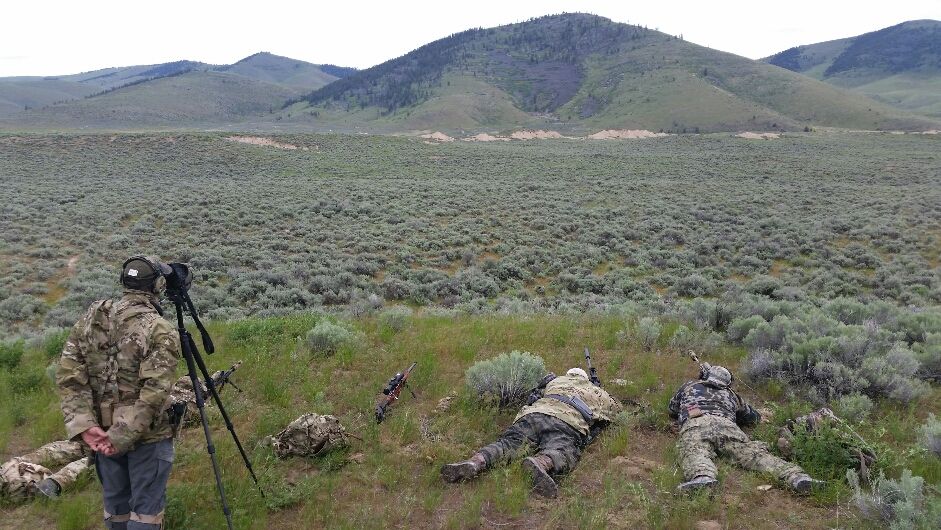
We pulled back to 900 yards. From this position, you needed to shoot from a higher position to see the targets. Since most of us aren’t steady enough to shoot from standing at this distance, some folks shot from truck beds and others broke out tripods. I was able to get some hits at this distance as well, though it was getting to the point where spotting my misses to make corrections was difficult.
With where we had the targets placed, we could have gotten back to about 980, but not quite to 1000 (a different target placement probably could have made that possible). Rather than push the distance again, we decided to pack it in and head back. I got some dinner with Eric (some excellent goose barbacoa). After dinner, we headed over to camp and enjoyed some more good beer and good conversation before turning in.
Monday
After the light primer strikes the previous day on Monday morning, I partially detail stripped the slide of my Glock. I got the firing pin cleaned off, as well as cleaning and lubing the whole gun generally.
We all met up there in camp. Eric gave a more detailed version of his 10 deadly “S”s lecture. He talked about different camouflage options. A ghillie suit was great for open country like where we’d been operating on Saturday and Sunday, but it’s not as useful in the woods where we’d be today and tomorrow. Not to mention, for long, foot-mobile operations ghillies are hot to wear and heavy to carry. This is much more the domain of BDUs or hunting camo.
Moving on, Eric went through the contents of his big Eberlestock Terminator pack. This was the longest gear discussion of the class since Eric has this pack set up for multi-day operations out in the woods. In addition to sniping kit, this includes heavy-duty sustainment gear like multiple days of food, clothing, a bivy shelter, sleeping bag, etc. It’s basically the same setup that Eric wrote about in his Everything but the Kitchen Sink article.

Eric broke out his sand table kit. This is a collection of little lengths of various colors of cordage, sponges, and other bits and bobs that he can use to lay out maps and diagrams as part of the mission planning process. He used these, along with a whiteboard and markers, to brief us on our initial mission we’d be performing when we got out to the class location.
Our job was to recon a structure on the property and gather the intel a commander would need to plan an assault. Eric talked about what kind of information was required: things like the number and location of windows and doors, window heights and coverings, available cover and its distance from the structure, whether different approaches would be passable for conventional vehicles or armored vehicles. Even down to things like the location of chimneys and roof vents (which can help you figure out the interior layout of a structure), where electrical and phone lines enter the building, and the presence of security lights and cameras.
Eric gave everyone a chance to get packed up (or repack their kit based on his gear lecture), then we mounted up and convoyed out to the property where we’d be doing the remainder of the class.
Once out there, Eric demonstrated using face paint to camouflage yourself. It’s more than just slapping a bunch of green on your face. You want to lighten sunken or shadowed areas of the face, like the eye sockets or under the chin, and lighten more prominent areas like the nose and cheeks. Then you add some blotches of contrasting colors to break up recognizable features like the eyes and mouth.
For this operation, Eric wanted us to carry our full load, including all the gear we’d need to stay out overnight. For me, this probably added up to over sixty pounds, plus rifle (I’d swapped over to the .308 AR for this portion of the class). We’d cache the big rucks near the objective and move forward with just our sniper kit for the recon and retrieve our rucks on the way out.

I got volunteered as team leader for the operation. We had five teams, so one team would be responsible for each side of the house, and one would get a good look at the gate. cdiesel and I took the gate, and the other teams each took one side of the house. Eric issued radios, but as a backup, we set a time for each team to finish their observations by and to pull back to the vehicles.
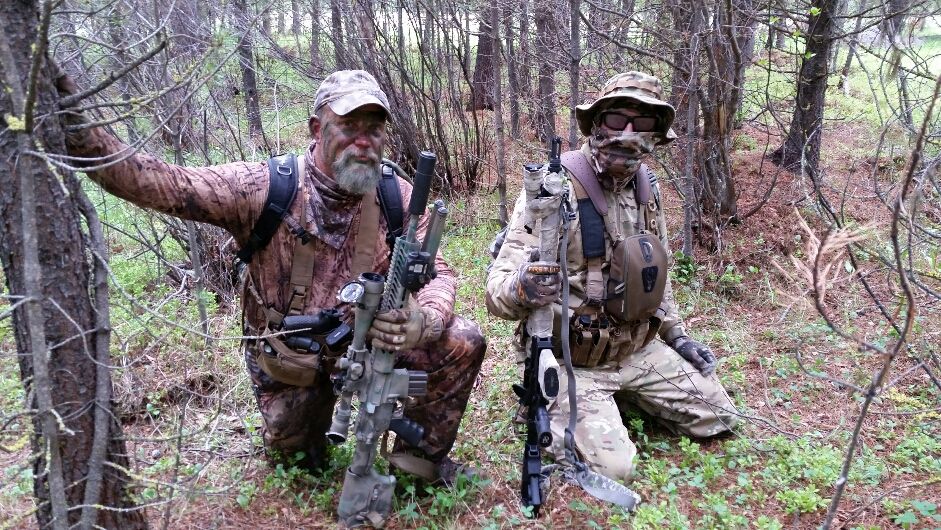
We stepped off and moved up as individual teams. I’m not the sneakiest guy when it comes to moving through the woods, but doing it in a big heavy ruck definitely added to the degree of difficulty. Not only did the big bulky pack tend to brush or catch on stuff, but the weight also pulled me off balance and made it difficult to bend down or lean to avoid branches.
After dropping our rucks, cdiesel and I moved up to our observation position and started glassing the gate and taking notes. The gate was pretty straightforward, so we also gathered what intel we could about the area as a whole, leaving the structure itself to the other teams. When the time came to pull back, we moved to our rucks and retrieved them. I found it took longer that I would like to get the Skycrane put back together. While I was doing that Eric walked by and spotted us.

We were the first ones back to the vehicles. One student had brought a small drone, so we also ran a bit of aerial surveillance on the target as well.
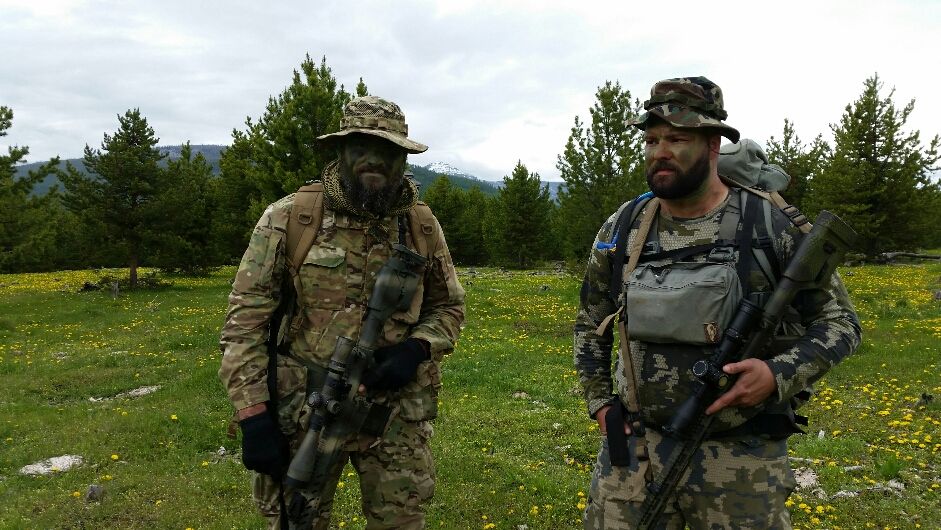
After everyone trickled in, we relayed our observations to Eric, having each team talk through what they seen and done. Some teams had a bit more of an adventure than we did (including one who got wet crossing the creek to get to their observing position).
We mounted up and drove on into the clearing where we’d be camping. We took a walk around the structure and debriefed the exercise. Generally, we’d done a good job of noting the relevant details of the structure.
Eric pressed some of us into service to go out and set up some steel targets at about 100 and 150 yards for our low light shooting later that night. With that accomplished, we took a bit of a break from class to get camp set up and get some dinner.
It doesn’t get dark until quite late in Montana this time of year, so we didn’t kick off the night shoot until after 10pm. Several folks had brought NVGs, so we started off shooting using those (I’d brought my PVS-14, but I don’t have a laser setup for this rifle yet, so I just watched). Once everyone who wanted to shoot with NVG had a chance, we went out and put some light sticks up on the targets so folks without night vision optics could shoot.
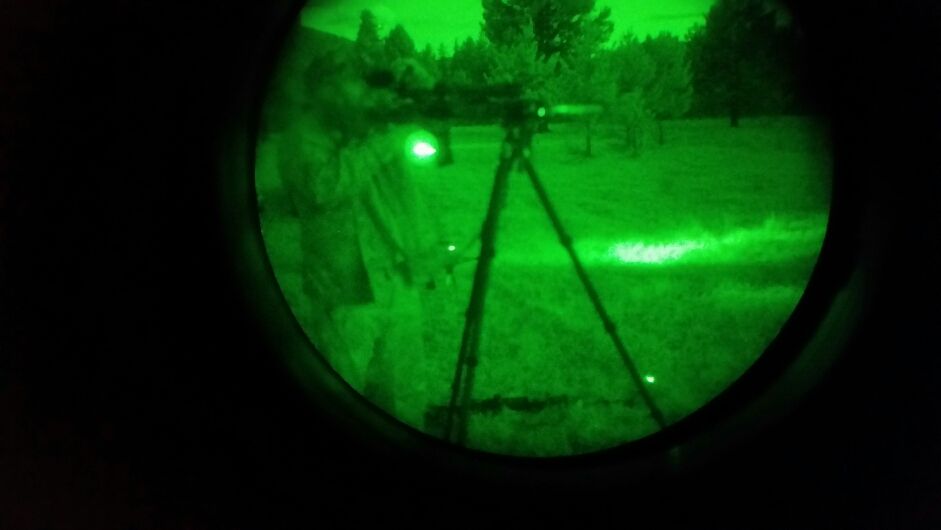
With that, Eric called an official end to the training day, and we broke out the booze. Some folks headed right for bed, but many of us stayed up until the wee hours enjoying some good fellowship with like-minded folks.
Tuesday
After a rather short night’s sleep, we all got breakfast going and got our kit squared away for the last day of class.
Eric started things off with another Kim’s game. After that, we did an exercise where he handed us a little smiley face, and we had to use our optics find the matching smiley on a sheet that had about 20 of them on it, each with slight visual differences. Then you had to engage your smiley. The smileys are only about an inch in diameter, so the accuracy standard is pretty high. To complicate things a bit further, Eric had us shoot this drill from about 60 yards. So if you didn’t know your intermediate holds before you get out to 100, you were in trouble. cdiesel and I were able to ID our smileys, but I missed mine. The round landed high, and a bit left.
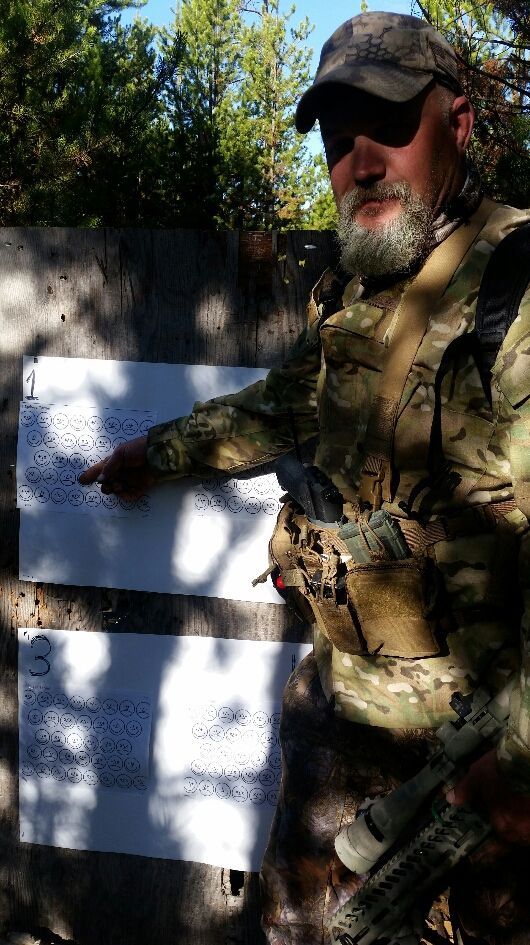
The next exercise had us moving one team at a time to the firing position where we’d done the night shoot last night. Our task was to engage a priority target (represented by a paper target) and a secondary target (represented by a steel plate). The priority target varied for each team. Some were given a photo of their target, others were given a photo of a hostage and told to shoot the hostage taker holding that person.
Since I had more magnification, I took the paper target while cdiesel took the steel. Again, I ended up shooting high and to the left. I hadn’t had a chance to check the zero this rifle (this and the previous drill were the first two rounds I’d put through it the entire class). My zero on this gun may not have been that great to begin with, and I’d popped the optic off of it for the trip out, so the fact that it was off was not entirely unexpected. I cranked in a rough guess at an adjustment based on my results on this drill.
After each team had shot the drill, we debriefed the Kim’s game from earlier.
Next, Eric briefed us on our final exercise. He gave each team a bunch of pictures of targets. Some were identified as bad guys who needed to be shot. Others were undercover officers or informants who we were not supposed to shoot.
The targets would be set up on one side of a large open meadow about half a mile away. Our task was to move to the near side of the meadow, covertly move into firing positions, ID the targets, engage, then pull back.

Once again, I got elected as team leader. I tried to stick with a fairly simple plan: everyone move up to the firing position as a unit, ID the bad guys, and each team simultaneously engage a BG based on their team number going from left to right (team 1 engages the leftmost BG, team 2 the second from left, etc.).
Eric suggested we establish an Objective Rally Point (ORP) where everyone could gather a bit short of our shooting positions and prep gear, sort out any last minute issues, etc. He also wanted us to pull back to that position after taking our shots.
We stepped off, moving in our 2-man teams with about a 25-yard interval between each team. cdiesel and I were team 5, so we were on the tail end. Our route paralleled a road, crossed a more minor dirt track, then paralleled that track into the objective.
After crossing the dirt track, the team running point held up. Eventually, cdiesel and I moved up to where they were stopped. I discovered that their understanding of our route didn’t match mine. I really should have had everyone (but particularly the lead team) brief back the route before we moved out. Once we got that sorted, we started moving parallel to the dirt track to our ORP.
When we got there, Eric suggested a leader’s recon to get eyeballs on our shooting position and the targets before everyone moved up there. I took one of the guys from the lead team, and we moved up to do the recon.
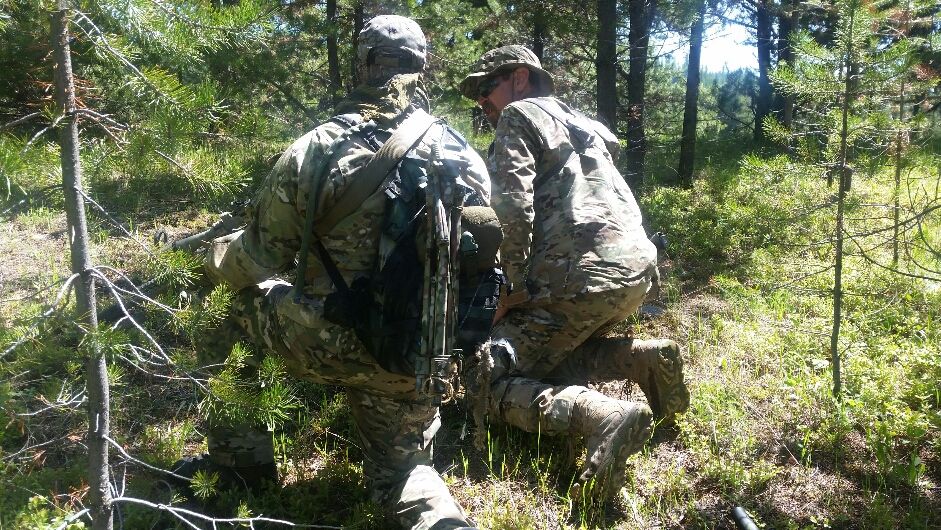
The shooting position Eric had selected for us was a very good one. The big open meadow we’d be shooting across ended with a line of trees and a slope down towards a small pond. The slope provided good terrain cover from the targets and meant that we could walk to within about 10 yards of our shooting positions before having to drop down to a crawl. The line of trees was thick enough to provide concealment while having enough gaps to use as shooting lanes that we could use to engage the targets. Across the meadow, I could see a bunch of 4’x 3’ wooden targets, each with two faces on them.
However, it quickly became apparent that we would have to push very far forward and expose ourselves quite a bit for every team to be able to see all the targets. Rather than having each team self-deploy and either move forward far enough to see all five targets or engage in a bunch of confused back and forth over which of the five targets each team was looking at, I decided that I’d place each team one at a time and designate a specific target for them so we could be sure that every target was covered.
We headed back to the ORP and briefed this to the team. Everyone moved up to the base of the slope as a unit, and I called one team up at a time and got them in position and pointed at a specific target. They got settled in, broke out the spotting scopes, and got to work IDing the targets.
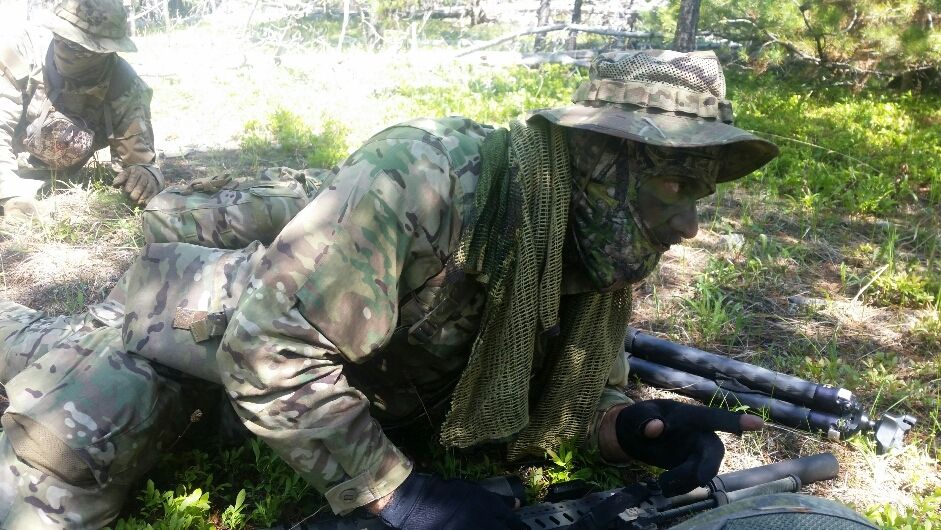
Since I was running around doing team leader stuff, cdiesel ended up out there on his own. I thought he’d need some more glass than just his ACOG, so I broke out my spotting scope and moved up to give it to him. Unfortunately, I misinterpreted his reply when I offered it to him and thought he was waving me off when he actually wanted to use the spotter. Fortunately, he was able to work with the team next to him to get his target identified.
We had one target board that was a little lower than the others, and that really caused the team I’d assigned to it some problems. They had to push further forward and expose themselves more to get even a tentative ID.
When everyone was settled into positions, we made sure rifles were clear, and Eric moved downrange to the targets and looked back towards us. Even though no one was ghillied up and we hadn’t done any real hide construction (just wearing camouflage with maybe a sniper veil thrown overhead and optics) Eric wasn’t able to locate anyone using his binos. I was moving around quite a bit behind the firing position, making sure each team had ID’d their targets and confirming that there was only one BG (and one no-shoot) on each target board. Even so, he didn’t spot me either.

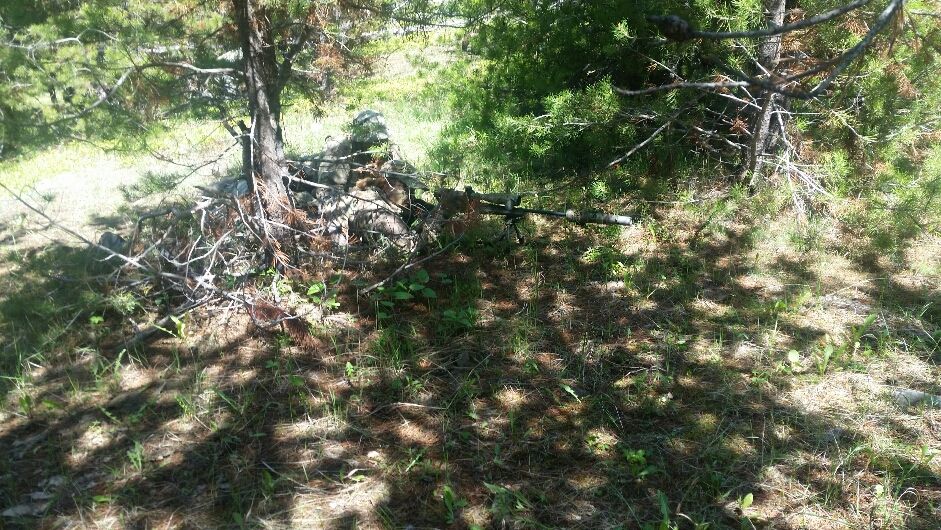

After Eric was back behind the firing line, we loaded rifles, and I called the count for the coordinated fire. In real life with teams spread out this far you’d probably do this with radio comms, but we “made pretend” and I just called it out verbally (or more formally, I “simulated radio communications” by speaking loudly). Most targets were engaged simultaneously by both members of the team assigned to that target, but because I was doing the count cdiesel was on his own. One of the other teams could only get one shooter in position to engage without exposing themselves. The coordinated fire worked well, with everyone firing so close together it sounded like one only slightly ragged shot.
We cleared rifles and Eric moved downrange to observe us while we pulled back. He threw in one slight curveball when he told everyone to police their brass as they withdrew (easy enough for the bolt gun guys, but more of a tall order for those shooting semi-autos). Eric had a bit more success spotting us as we withdrew. He made two bits of movement, one very fleeting, the other more obvious and sustained (sustained enough he could have engaged).
After finishing our pullback, we walked out to the targets to debrief. The shooting results were a bit more mixed. Two were solid hits, two more flesh wounds, and one clean miss.
We hiked back to camp, moving non-tactically down the road. There everyone got packed up and loaded our kit, Eric handed out certificates, and we headed out. We convoyed back down the mountain to the main camp where some people had left vehicles and gear. Folks who were headed elsewhere peeled off as appropriate.
Eric and I headed over to his place, and we enjoyed a nice dinner and some beer before making an early night of it.
Conclusions
This was a fantastic class. The long range stuff on Saturday and Sunday was great, but for me, the field work on Monday and Tuesday was the main event. There are few people better at teaching this kind of stuff than Eric, and he really delivered during this class.
As great of an instructor as Eric is, a lot of credit also goes to my fellow students. Everyone contributed significantly to the class. We had a lot of great questions that pushed Eric to elaborate on certain aspects of the material. Many students had experience hunting or shooting long range, and they were able to provide some additional perspective. After the training day was over, there was also some great fellowship among like-minded folks. I thoroughly enjoyed hanging out with this crew.
I had a good shooting partner in cdiesel. He did a great job spotting and pushed the ACOG on the SCAR farther than I would have thought possible. He did a great job holding up our team’s responsibilities when I got sucked into the TL role in the last exercise, and I need to thank him for that.
The Ruger Precision Rifle ran great. It’s a bit of a heavy SOB, but it shoots very accurately. The Vortex 3-18 ran well, using both holdovers and dialing my elevation. I’m liking the Magpul bipod. It’s not as good as my Atlas, but for 1/3 of the cost, you get a lot more than 1/3 of the capability. I’d much rather run this than a Harris or Versapod style bipod. The only thing I’m really missing is QD capability.
I really should have confirmed zero on .my 308 AR on Saturday, even if it meant holding up the class at 100 for a bit longer. There were some more adventures with this rifle accuracy and reliability wise later in this week, which you can read about below.
The Leupold spotting scope ran well, as usual. I am very tempted by the nice tripod Sammy brought for his spotting scope setup. I think I may get a bigger tripod for range use, and maybe something even smaller and more compact for use in the field. My current tripod tries to split the difference between these two roles and doesn’t do either of them optimally.
The Vortex Fury laser rangefinding binoculars worked great. I’m very impressed by the glass on these, and the LRF was effective out to 900 yards (I even pinged a hillside beyond where we were shooting at 1300, though I wasn’t able to confirm that number). Having the laser and binos in a single package was very convenient. I gave Eric a peep through them, and he was pretty impressed as well. I think I may have cost him some money on this trip (turnabout is fair play).
The Badlands bino case worked well. There were a few instances where I wished it was more compact when I was crawling around in the dirt or had to shift it a bit when I got behind the rifle, but generally, it stayed out of the way and kept the binos well protected.
I’m loving the Crye G3 and G4 pants (if anything I think I like the older G3 design a bit better). The knee pads rock for this kind of stuff, though I probably got as much mileage out of them kneeling by the campfire on Monday night as I did doing sniper stuff. Multicam is a good choice for Montana, but this early in the season you could have gotten away with a greener color scheme like woodland BDUs.
My backpacking gear worked as it always does. I was snug and warm even down below freezing the night we slept out. The new Jetboil worked well. I got the bigger pot, which was definitely appropriate for cooking dinner, but I could see a role for a more compact stove as well.
I’m a bit more mixed on the Skycrane system. I like the Little Brother pack as a sniper ruck (it’s got a lot in common with the Eberlestock Halftrack I usually use in that role). However, I’m not entirely satisfied with how long it takes to get in and out of the Skycrane. The Skycrane carried all my gear well, but it’s a pack that tends to get wider side to side and deeper front to back as you add stuff to it. Being 6’5”, I’d really prefer something that gets taller. The biggest issue is that the Skycrane doesn’t really have much in the way of external storage that you can access easily. The Little Brother is kind of buried, and the Spike duffel that sits on the outside is just one big compartment without any organization. I may have an Eberlestock Terminator like Eric’s in my future (though if I get out of a class like this with Eric and that’s the most expensive thing I buy I’ll count myself lucky). I already picked up a Mongo Versapack shoulder bag from Eric, and I’m going to set that up as a small sniper pack as well (which will require slimming down some of my gear).
Using the carry-on sized Pelican case for my optics worked out pretty well. No problems getting it through the security checkpoint at the airport. I did end up having to gate check it for the Denver-Missoula and Missoula-Denver legs (itty bitty airplane with tiny overhead bins) but that’s a lot less handling and time out of sight than if I’d checked it as baggage.
I’ll definitely be making some changes to my kit after this class. Lots of small “quality of life” improvements like using the Maxpedition pocket organizers to carry kit in cargo pockets, carrying stuff like cough drops, wet wipes, and a microfiber towel. He also demonstrated using an ID card holder dummy corded to your bag to hold dope cards, which is just genius. I’ll also be setting up “on gun” and “drag bag” kits for each of my sniper-type rifles.
I’ve talked a bit with Eric about what he wants to do next year and the possibilities that the areas we used for this class have to offer. It sounds like there’s some awesome stuff on tap.
More Montana
Wednesday
The end of class on Tuesday was not the end of my Montana adventures. I’d decided to take the whole week off and wasn’t flying out until Sunday afternoon, so I had some time to hang out with Eric and see if I could fill my bear tag.
Eric had to work a shift on Wednesday, so I spent the morning I doing some work on this writeup. Eric picked me up about noon, and I spent the afternoon doing a ride-along with him.
We swung by the range to take care of the zero on my .308 AR. I was able to get on target, but the experience confirmed that the load that I’m shooting does not group very well out of this gun (it’s the Fiocchi loading of the Barnes 168 grain TTSX bullet). It’s still minute of bear through. However, I also had a couple of failures to cycle as I got down to the bottom of the magazine.
After my light primer strike issues on Monday, I also took my 10mm Glock out to test with a couple mags of ball ammo. I had 3 failures to fire in a row. At that point, I just walked back uprange in frustration.
After thinking about it and talking with Eric, I decided to try some of my hollowpoint carry ammo in it. I was reluctant to do this since I’d only brought two mags worth of hollowpoints (along with two mags of hard cast for bear defense). Shooting some of the carry ammo would leave me less than a minimal loadout for self-defense, However, given the effect, these problems were having on my confidence in this pistol I effectively had zero rounds of useful ammo, so there wasn’t much to lose.
I walked back downrange and blew through a full mag of carry ammo rapid fire. As Eric succinctly out it when I got back to the bench, “You have an ammo problem, not a gun problem.” I got my confidence in my Glock back, though now I was a bit light on ammo (I just carried a mag of hard cast as my reload for the rest of the trip). I gave what was left of the 10mm ball to Eric; maybe it’ll go bang in one of his guns.
That evening we did a road hunt for some bear. We loaded up Eric’s family in the truck and drove up into the mountains west of town, keeping an eye out as we drove and glassing open areas for bear. We kept at it until dusk (pretty late this time of year in Montana). No luck with the bear, but time spend driving around the Montana woods in such good company is by no means wasted.
After some chow and beer at Eric’s place, I drove back to his trailer and turned in for the night.
Thursday
After the late night road hunting last night we got a fairly leisurely start today. Eric and I headed out to an area where we could get some distance and checked the dope on a couple of his rifles. I also tested out my .308 AR at 300 yards. After the failures to cycle on my .308 AR, I’d opened up the gas setting on my adjustable gas block another notch. There were no troubles cycling, but I did have one round fail to fire.
